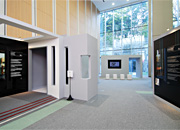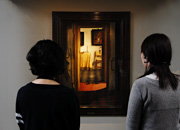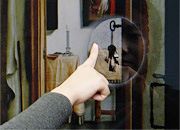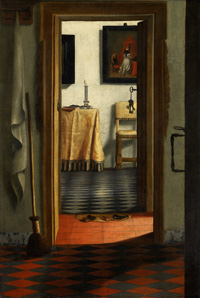|
 |
Louvre-DNP Museum Lab Customer Center
Tel: +81 (0) 35435 0880, Monday to Friday, 9 a.m. to 6 p.m. Closed on Saturday,Sundays and public holidays. |
|
 |
|
 |
The fifth Louvre - DNP Museum Lab presentation features a work by Samuel Van Hoogstraten entitled The Slippers, one of the finest in the Louvre's collection of Dutch paintings.
A pupil of Rembrandt and contemporary of Vermeer, Samuel Van Hoogstraten, who was alive in the 17th century, was one of the major artists of the golden age of Dutch painting.
Born of the painter's particular interest in space construction, this work is typical of Dutch genre painting in that it depicts an interior scene, yet the absence of human figures makes it highly atypical.
From the foreground to the background, in this interior scene devoid of human figures, we can see a broom, slippers, keys, a candle, and a painting within a painting.
As the eye moves around this silent space, the objects seemingly take on new significance drawing the viewer into the scene.
The experiment offered this time seeks to let visitors discover gradually, through their individual analysis and interpretation, the subtle devices orchestrated by the artist in the creation of this painting. |
 |
 |
 |
 |
Viewers become aware of their participation in the artwork |
 |
 |
|
The Slippers is recognized as one of Van Hoogstraten's works that best illustrates the results of his research into the representation of space, be it perspective or trompe l'œil. The painter used a number of artistic devices that guide the viewer's gaze and let him question about his role as a viewer.
In addition to the appreciation and understanding of an artwork, this fifth presentation is designed to encourage reflection on the viewer's role. Visitors can engage in a dialogue with the painting that prompts a sense of involvement in the artist's work. |
 |
 |
|
 |
 |
 |
 |
Piercing the secrets of the illusion |
 |
 |
|
| How does this painted interior convey such a sense of reality? How is the viewer's gaze progressively guided through the series of rooms? Why is it irresistibly drawn into the heart of the work? The fifth Museum Lab presentation uses a range of resources to help visitors discover the secrets of the optical illusions in this painting. |
 |
 |
|
Visitors can physically experience the interior depicted in The Slippers through the projection of a human-sized reproduction of the scene, which evolves according to their movements.
Another resource features a reproduction of the painting on a work table which allows the visitor to play the role of a researcher, examining and analyzing Van Hoogstraten's way of representing space and coming to appreciate the subtleties of his pictorial techniques.
What were the practical applications of Van Hoogstraten's lifetime obsession with visual perception? Museum Lab also presents a number of the artist's representative works to demonstrate the basic principles he developed as a result of his research. |
 |
 |
|
 |
 |
 |
 |
A personal interpretation of the work |
 |
 |
|
| A number of everyday objects are depicted in this painting: keys, a broom, etc. These objects are said to contain a symbolic meaning which could provide precious clues to an understanding of the work. But is it really necessary to look for a hidden meaning in the delightfully mysterious atmosphere of this painting? |
 |
 |
|
| This painting, originally entitled View of an Interior, was renamed The Slippers in the 19th century. This fifth presentation is another opportunity to reinterpret Van Hoogstraten's work, thanks this time to visitors' impressions. Every visitor to Museum Lab can choose from a range of suggested interpretations, and share his or her impressions in real time with other visitors - an opportunity to realize the extent to which reactions to a painting can differ according to inidividual sensibilities, and how the interpretation of an artwork can evolve over time. |
 |
 |
|
|
| When visitors see that others either share their impression or have a totally different interpretation, they can go back to look at the painting again. This purpose of this second observation is to try to be fully aware of how the gaze operates. Having explored the construction of the painting in detail, visitors may now realize that their insight into the painter's intentions gives them a different view. Who knows, perhaps their very perception of the painting will have changed, creating a new relationship between artwork and viewer and allowing the latter to rediscover his place in relation to the painting. |
 |


between 1654 and 1662
Oil on canvas
H. 1.03 m; W. 0.70 m
Musée du Louvre, Paris
R.F. 3722
© 2008 Musée du Louvre / Georges Poncet |
 |
|
|

